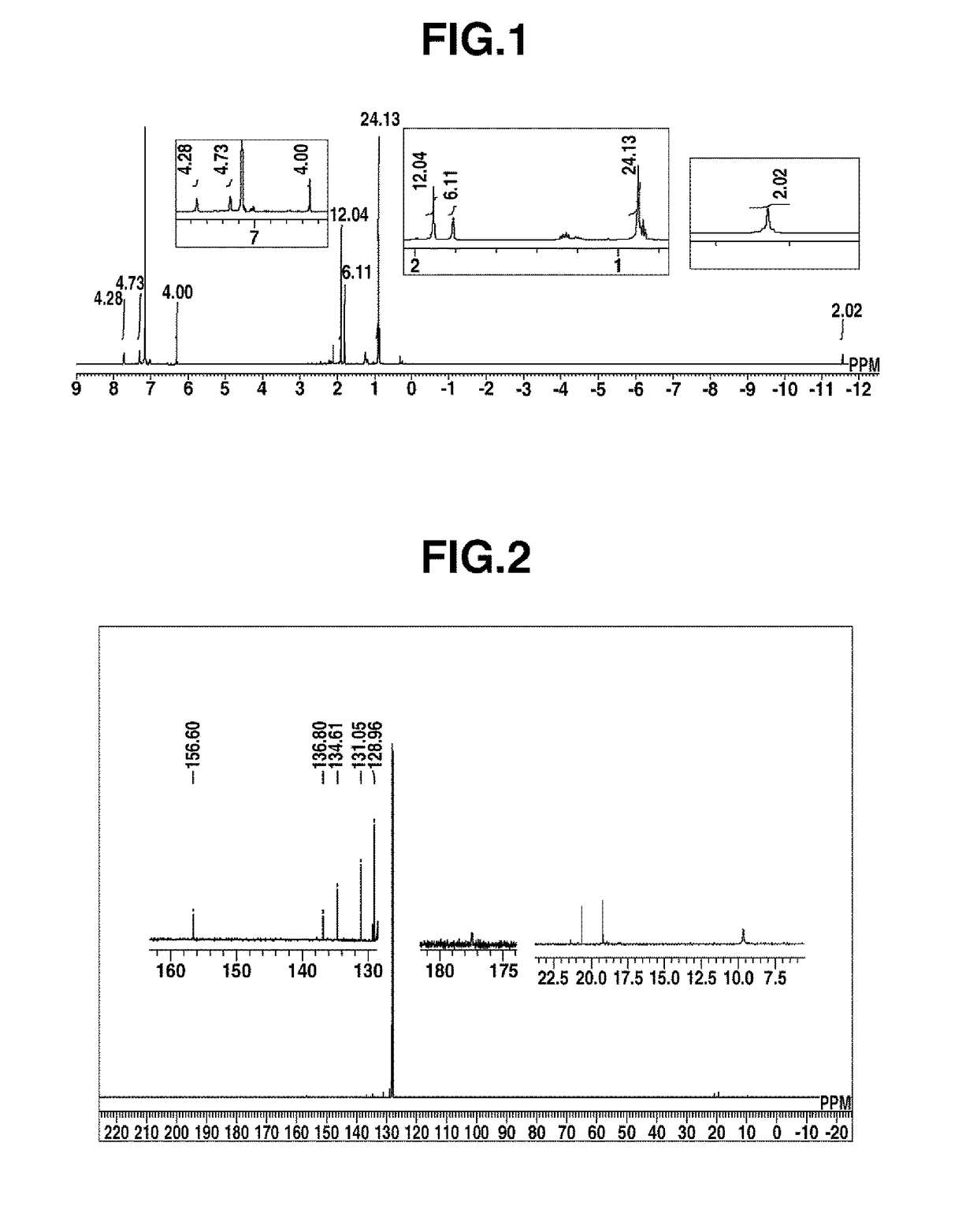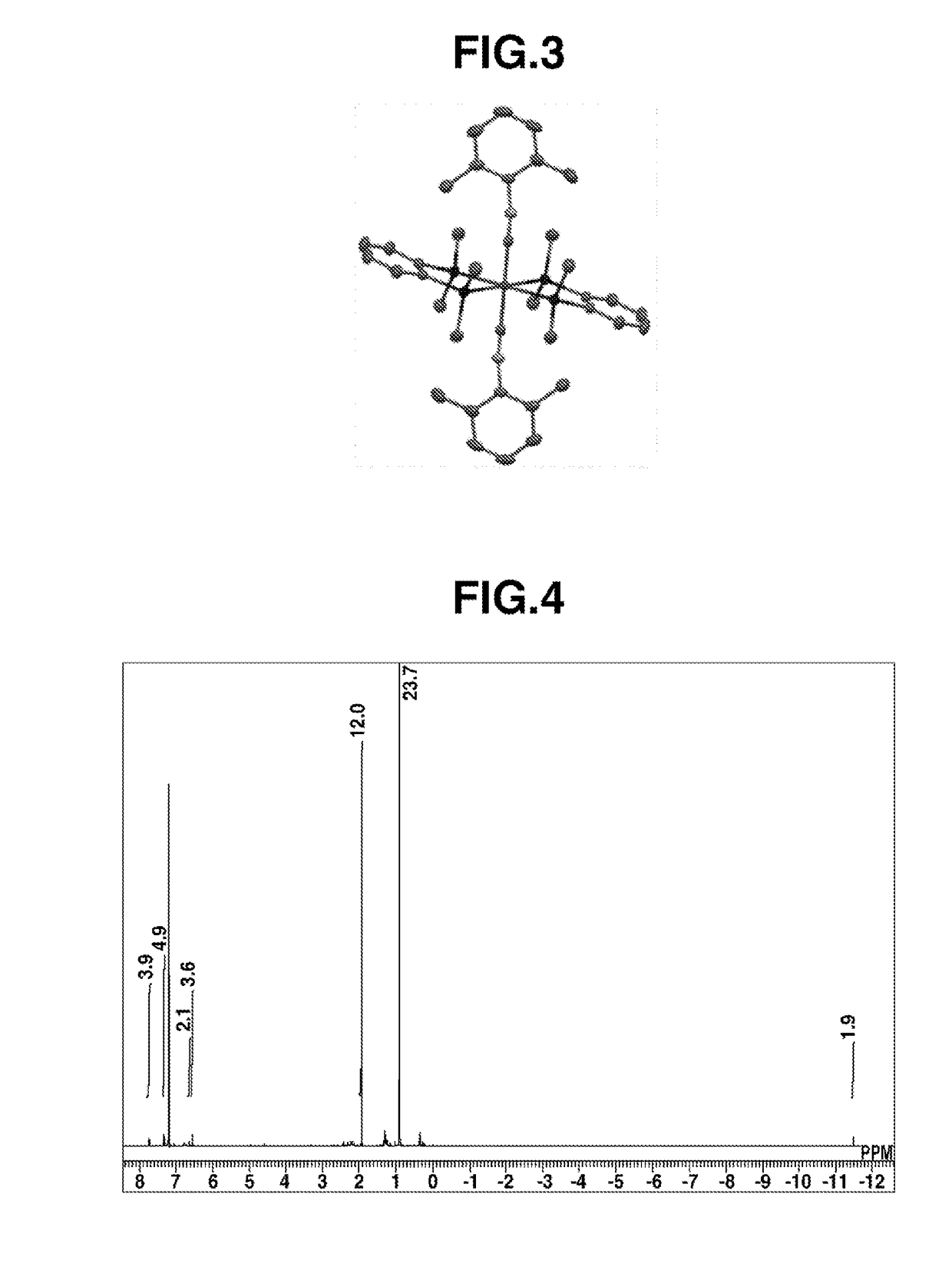Mononuclear iron complex and organic synthesis reaction using same
a technology of mononuclear iron and organic synthesis, which is applied in the field of mononuclear iron complex, can solve the problems of low selectivity between -adducts and -adducts, the unreacted olefin is left in the addition product, and the cost of all pt, pd and rh as the center metal is very expensive noble metal elements, and achieves preferential progress of the addition reaction
- Summary
- Abstract
- Description
- Claims
- Application Information
AI Technical Summary
Benefits of technology
Problems solved by technology
Method used
Image
Examples
example 1
Synthesis of Iron Complex A
[0171]
[0172]Herein Me stands for methyl.
[0173]A 100-mL Schlenk tube under argon atmosphere was charged with (η6-1,3,5,7-cyclooctatetraene)(η4-1,3,5,7-cyclooctatetraene)iron(0) complex (40 mg, 0.15 mmol) and 2,4,6-trimethylphenyl isocyanide (66 mg, 0.45 mmol), to which hexane (40 mL) which had been deaerated and dried was added. The contents were stirred at room temperature for 1 hour, after which 1,2-bis(dimethylsilyl)benzene (64 mg, 0.33 mmol) was added. The reactor interior was purged with hydrogen atmosphere. Under light irradiation using a high-pressure mercury lamp (UM-453B-A, 450 W, by Ushio Inc.), the contents were stirred at room temperature for 48 hours. After the completion of reaction, the reaction mixture was dried in vacuum. The dry product was dissolved in toluene (10 mL), from which a small amount of black insoluble matter as by-product was removed by centrifugation. Thereafter, the toluene solution was dried in vacuum, yielding iron complex...
example 2
Synthesis of Iron Complex B
[0182]
[0183]Herein Me stands for methyl.
[0184]A 100-mL Schlenk tube under argon atmosphere was charged with (η6-1,3,5,7-cyclooctatetraene)(η4-1,3,5,7-cyclooctatetraene)iron(0) complex (100 mg, 0.38 mmol) and 2,6-dimethylphenyl isocyanide (149 mg, 1.14 mmol), to which hexane (60 mL) which had been deaerated and dried was added. The contents were stirred at room temperature for 1 hour, after which 1,2-bis(dimethylsilyl)benzene (162 mg, 0.83 mmol) was added. The reactor interior was purged with hydrogen atmosphere. Under light irradiation using a high-pressure mercury lamp (UM-453B-A, 450 W, by Ushio Inc.), the contents were stirred at room temperature for 48 hours. After the completion of reaction, the reaction mixture was dried in vacuum. The dry product was dissolved in toluene (10 mL), from which a small amount of black insoluble matter as by-product was removed by centrifugation. Thereafter, the toluene solution was dried in vacuum, yielding iron complex...
example 3
Synthesis of Iron Complex C
[0191]
[0192]Herein Me stands for methyl.
[0193]A 100-mL Schlenk tube under argon atmosphere was charged with (η6-1,3,5,7-cyclooctatetraene)(η4-1,3,5,7-cyclooctatetraene)iron(0) complex (50 mg, 0.19 mmol) and adamantyl isocyanide (92 mg, 0.57 mmol), to which hexane (50 mL) which had been deaerated and dried was added. The contents were stirred at room temperature for 1 hour, after which 1,2-bis(dimethylsilyl)benzene (80 mg, 0.42 mmol) was added. The reactor interior was purged with hydrogen atmosphere. Under light irradiation using a high-pressure mercury lamp (UM-453B-A, 450 W, by Ushio Inc.), the contents were stirred at room temperature for 48 hours. After the completion of reaction, the reaction mixture was dried in vacuum. The dry product was dissolved in toluene (5 mL), from which a small amount of black insoluble matter as by-product was removed by centrifugation. Thereafter, the toluene solution was dried in vacuum, yielding iron complex C (55 mg, 0....
PUM
| Property | Measurement | Unit |
|---|---|---|
| temperature | aaaaa | aaaaa |
| temperature | aaaaa | aaaaa |
| pressure | aaaaa | aaaaa |
Abstract
Description
Claims
Application Information
 Login to View More
Login to View More - R&D
- Intellectual Property
- Life Sciences
- Materials
- Tech Scout
- Unparalleled Data Quality
- Higher Quality Content
- 60% Fewer Hallucinations
Browse by: Latest US Patents, China's latest patents, Technical Efficacy Thesaurus, Application Domain, Technology Topic, Popular Technical Reports.
© 2025 PatSnap. All rights reserved.Legal|Privacy policy|Modern Slavery Act Transparency Statement|Sitemap|About US| Contact US: help@patsnap.com



